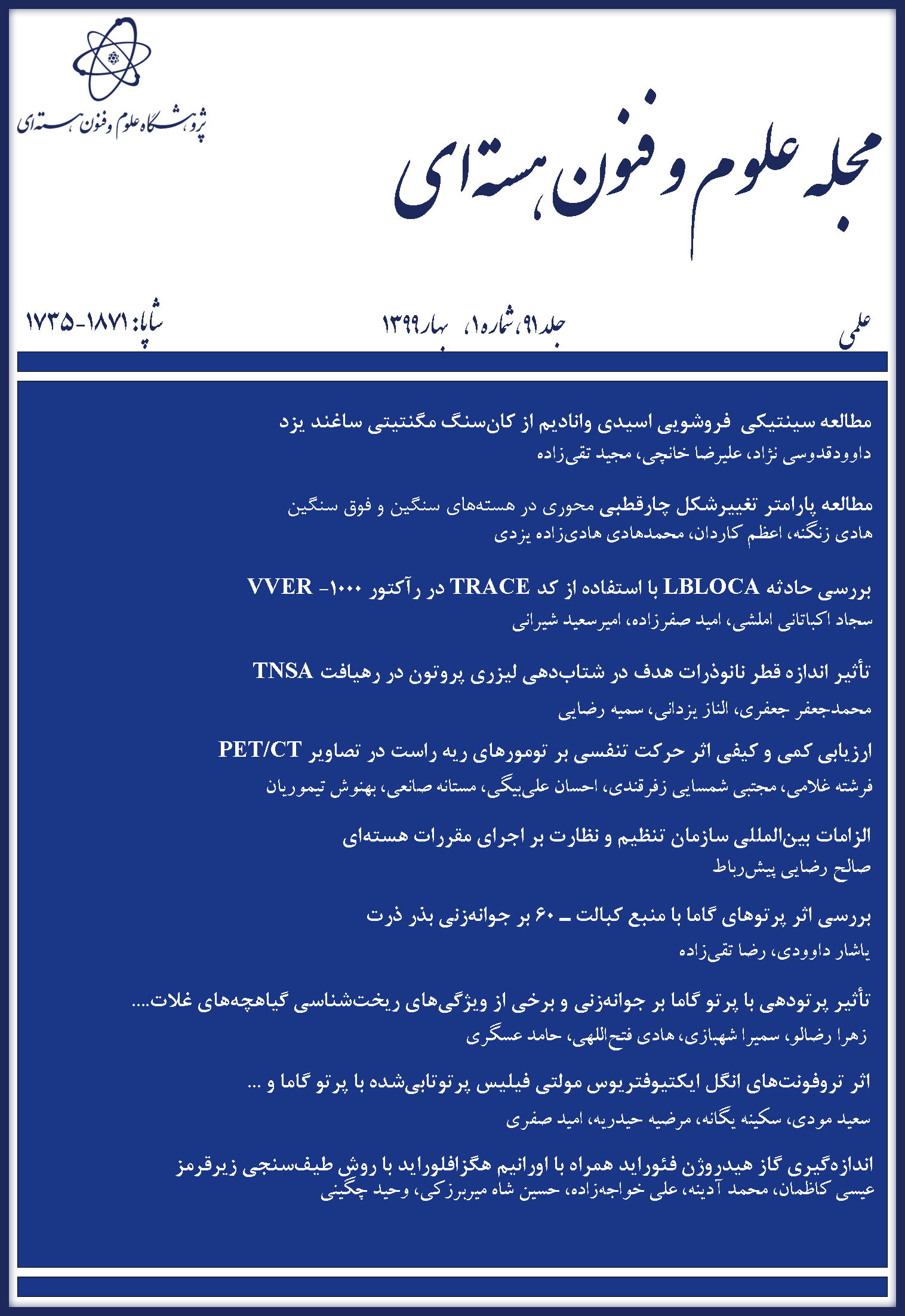نوع مقاله : مقاله پژوهشی
نویسندگان
پژوهشکده فیزیک و شتابگرها، پژوهشگاه علوم و فنون هستهای، سازمان انرژی اتمی ایران، صندوق پستی: 14155-1339، تهران- ایران
چکیده
مواد پروسکایت هالید سرب شبه دوبعدی نسبت به پروسکایتهای سه بعدی پایداری بهتر و بازده بالایی در آشکارسازی پرتوهای ایکس و گاما دارند و لذا کاندید مناسبی جهت استفاده در آشکارسازهای سوسوزن میباشند. در این پژوهش، ابتدا دلیل پایداری ساختار شبه دوبعدی نسبت به همتای سه بعدیش یعنی با استفاده از نظریه تابعی چگالی و محاسبات اصول اولیه مورد بررسی قرار گرفت. نتایج بهدست آمده نشان داد انتقال بار از اتمهای هیدروژن متصل به اتم نیتروژن در مولکول آلی و اتمهای ید نزدیک به مولکول آلی، و نیز تغییر توزیع بار در ساختار پروسکایت دوبعدی منجر به پایداری بیشتر این ساختارها نسبت به ساختارهای حجمی میشود. در گام دوم محاسبات، خواص مکانیکی مورد بررسی قرار گرفت. ساختار شبه دوبعدی با وجود پایداری بالا، به دلیل حضور مولکولهای آلی بزرگ، دارای خواص مکانیکی ضعیفتری نسبت به همتای سه بعدیش یعنی بوده و به عبارتی، ساختار شبه دوبعدی تحمل کمتری در برابر فشارهای خارجی از خود نشان داد. بنابر نتایج حاصل از این پژوهش، استفاده از ساختار شبه دوبعدی به عنوان آشکارساز سوسوزن در محیطهای سخت، میتواند ناکارآمدتر از ساختار همتای سه بعدی باشد.
کلیدواژهها
عنوان مقاله [English]
An ab-initio study of mechanical properties and stability of the quasi-two-dimensional HA2CsPb2I7 perovskite and inorganic CsPbI3
نویسندگان [English]
- S. Nazari
- N. Babaei Bidmeshki
Physics & Accelerator School, Nuclear Science and Technology Research Institute, AEOI, P.O.Box: 1339-14155, Tehran - Iran
چکیده [English]
Due to their better stability and high performance for X- and gamma-ray detection, quasi-two-dimensional (2D) lead halide perovskites have demonstrated excellent ability to be used in scintillators, compared to three-dimensional (3D) perovskites. In the current study, the stability of 2D-layered HA2CsPb2I7 was investigated relative to the α-CsPbI3 crystal structure. It is demonstrated that the charge transfer of hydrogen atoms connected to nitrogen and iodine atoms close to organic molecules in the 2D structure. This results in a change in charge distribution over the perovskite structure. Hence, the structural stability of the 2D structure was much better than the cubic structure of α-CsPbI3. Despite the more stability of quasi-2D perovskite, the presence of large organic molecules in this structure led to lower mechanical stability than its 3D counterpart, α-CsPbI3. In other words, this material has less tolerance for the pressure of time. According to the results, scintillation detectors based on 2D lead halide perovskites can be less efficient in harsh conditions than their 3D counterparts.
کلیدواژهها [English]
- Quasi-two-dimensional perovskite
- Formation energy
- Molecular organic
- Charge transfer
- Mechanical stability
- Bulk modulus
- Zhou F, Li Z, Lan W, Wang Q, Ding L, Jin Z. Halide Perovskite, a Potential Scintillator for X‐Ray Detection. Small Methods. 2020;4:2000506.
- Kishimoto S, Shibuya K, Nishikido F, Koshimizu M, Haruki R, Yoda Y. Subnanosecond time-resolved x-ray measurements using an organic-inorganic perovskite scintillator. App. Phys. Let. 2008;93:261901.
- Wei H, Fang Y, Mulligan P, Chuirazzi W, Fang H-H, Wang C, Ecker B.R, Gao Y, Loi M.A, Cao L, Huang J. Sensitive X-ray detectors made of methylammonium lead tribromide perovskite single crystal. Nature Photonics. 2016;10:333.
- Leijtens T, Eperon G.E, Noel N.K, Habisreutinger S.N, Petrozza A, HJ Snaith H.J. Stability of metal halide perovskite solar cells. Advanced Energy Materials. 2015;5:1500963.
- Shpatz Dayan A, Cohen B.E, Aharon S, Tenailleau Ch, Wierzbowska M, Etgar L. Enhancing stability and photostability of CsPbI3 by reducing its dimensionality. Chem. Mat. 2018;30:8017.
- Kumar S, Jagielski J, Yakunin S, Rice P, Chiu Y.C, Wang M, Nedelcu G, Kim Y, Lin S, Santos E.J.G, Kovalenko M.V, Shih C-J. Efficient blue electroluminescence using quantum-confined two-dimensional perovskites. ACS Nano. 2016;10:9720.
- Lin J.T, Liao C.C, Hsu C.S, Chen D.G, Chen H.M, Tsai M.K, Chou P.T, Chiu C.W. Harnessing dielectric confinement on Tin perovskite to achieve emission quantum yield up to 21%. J. Am. Chem. Soc. 2019;141:10324.
- Datta A, Fiala J, Motakef S. 2D perovskite-based resolution X-ray detectors. Sci. Rep. 2021;11:22897.
- Gao H, Wei W, Li L, Tan Y, Tang Y. Mechanical properties of a 2D lead-halide perovskite, (C6H5CH2NH3) 2PbCl4, by nanoindentation and first-principles calculations. The Journal of Physical Chemistry. C. 2020;124(3):19204-19211.
- Jiang Y, Yuan J, Ni Y, Yang J, Wang Y, Jiu T, Yuan M, Chen J. Reduced-dimensional α-CsPbX3 perovskites for efficient and stable photovoltaics. Joule. 2018;2:1356.
- https://dalcorso.github.io/thermo_pw.
- Voigt W. Lehrbuch der kristallphysik: (mit ausschluss der kristalloptik). BG Teubner. 1910;3.
- Landau L.D, Lifshitz E.M. Theory of elasticity, 3rd ed. Pergamon Press, Oxford. 1986.
- Afsari M, Boochani A, Hantezadeh M. Electronic, optical and elastic properties of cubic perovskite CsPbI3: Using first principles study. Optik. 2016;127(2):11433.
- Kaxiras E. Atomic and electronic structure of solids, 1st ed. Cambridge University Press, Cambridge. 2003.

